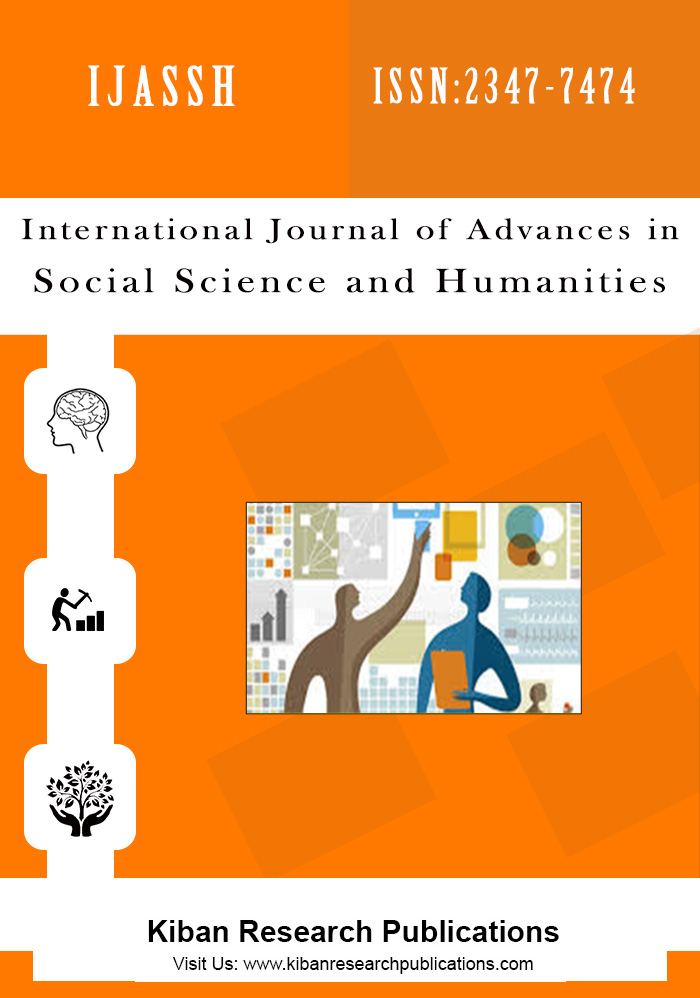Childhood Anemia in Bihar, India: Patterns and Determinants
Abstract
Anemia is a significant global public health issue that is worse among children and pregnant women. World Health Organisation reported that 42% of children under five years of age and 40% of pregnant mothers worldwide are anemic. Anemia is one of the most commonly prevalent nutritional problems across the countries, affecting almost all ages, sex, and physiological groups especially the vulnerable groups. It adversely affects the morbidity and mortality among children. An assessment of the pattern and determinants of childhood anemia in Bihar is carried out in this study. The data from the National Family Health Survey conducted during 2015-16 is used in this study to examine the scenario of childhood anemia in Bihar. The bivariate and binary logistic regression models were used to accomplish the study objectives. The anemia prevalence is in Bihar (64%) is 5% higher than the national average (59%). The results from the binary logistic regression model show that the children with lower educated mothers, poor household wealth status, higher birth order, and female sex have a significantly higher risk of childhood anemia in Bihar. Further, Bhagalpur, Kosi, and Darbhanga division of Bihar have a higher risk of childhood anemia. Therefore, it is recommended that socioeconomically, demographically, and regionally backward sections should get focussed on policy modification and program interventions.
Keywords: Anemia, Hemoglobin deficiency, Iron deficiency, Regional pattern, Kosi.
References
Bizzarro, M. J., Colson, E., & Ehrenkranz, R. A. (2004). Differential diagnosis and management of anemia in the newborn. Pediatric Clinics of North America, 51(4), 1087-107.
Black, R. E., Allen, L. H., Bhutta, Z. A., Caulfield, L. E., De Onis, M., Ezzati, M., ... & Maternal and Child Undernutrition Study Group. (2008). Maternal and child undernutrition: global and regional exposures and health consequences. The lancet, 371(9608), 243-260.
Brown, S. P. (1996). A meta-analysis and review of organizational research on job involvement. Psychological bulletin, 120(2), 235.
Casey, G. J., Phuc, T. Q., MacGregor, L., Montresor, A., Mihrshahi, S., Thach, T. D., ... & Biggs, B. A. (2009). A free weekly iron-folic acid supplementation and regular deworming program is associated with improved hemoglobin and iron status indicators in Vietnamese women. BMC Public Health, 9(1), 261.
Group Symposium. Why is iron important and what to do about it: a new perspective. Washington, DC, INACG Secretariat, 2002: 1-50 ....
IIPS, I. (2017). National Family Health Survey (NFHS-4), 2015–16. International Institute for Population Sciences (IIPS), Mumbai, India.
Janus, J., & Moerschel, S. K. (2010). Evaluation of anemia in children. American family physician, 81(12), 1462-1471.
Johnston, J. L., Gillespie, S., & Micronutrient Initiative. (1998). Expert Consultation on Anemia Determinants and Interventions: proceedings of a conference held Sept. 16-17, 1997, Ottawa, Canada. Micronutrient Initiative, Ottawa, ON, CA.
KAPIL, U. (2002). Technical consultation on Strategies for Prevention and Control of Iron Deficiency Anemia amongst under three children in India. Indian pediatrics, 39(7), 640-647.
Khan, L. (2018). Anaemia in childhood. Paediatric annals, 47(2), e42-e47.
Kotecha, P. V. (2011). Nutritional anemia in young children with focus on Asia and India. Indian journal of community medicine: official publication of Indian Association of Preventive & Social Medicine, 36(1), 8.
Kuate-Defo, B. (2001). Modeling Hierarchically Clustered Longitudinal Survival Processes with Applications to Child Mortality and Maternal Health. Canadian Studies in Population [ARCHIVES], 535-561.
Kumar, A. (1999). National nutritional anaemia control programme in India. Indian journal of public health, 43(1), 3.
Larson, L. M., Young, M. F., Ramakrishnan, U., Webb Girard, A., Verma, P., Chaudhuri, I., ... & Martorell, R. (2017). A cross-sectional survey in rural Bihar, India, indicates that nutritional status, diet, and stimulation are associated with motor and mental development in young children. The Journal of nutrition, 147(8), 1578-1585.
Lopez, A., Cacoub, P., Macdougall, I. C., & Peyrin-Biroulet, L. (2016). Iron deficiency anaemia. The Lancet, 387(10021), 907-916.
Milman, N. (2011). Postpartum anemia I: definition, prevalence, causes, and consequences. Annals of hematology, 90(11), 1247.
Murphy, J. F. Haemoglobin concentrations for the diagnosis of anaemia and assessment of severity. Vitamin and Mineral Nutrition Information System. Geneva, World Health Organization, 2011 (WHO/NMH/NHD/MNM/11.1; http://www. who. int/vmnis/indicators/haemoglobin. pdf, accessed 1 December 2012). 4. International Anemia Consultative Group. Report of the 2001 International Anemia Consultative.
Ngnie-Teta, I., Kuate-Defo, B., & Receveur, O. (2009). Multilevel modelling of sociodemographic predictors of various levels of anaemia among women in Mali. Public health nutrition, 12(9), 1462-1469.
Oliveira, M. A., Osório, M. M., & Raposo, M. C. (2007). Socioeconomic and dietary risk factors for anemia in children aged 6 to 59 months. Jornal de Pediatria, 83(1), 39-46.
Osório, M. M. (2002). Determinant factors of anemia in children. J Pediatr (Rio J), 78(4), 269-78.
Osório, M. M., Lira, P. I., Batista-Filho, M., & Ashworth, A. (2001). Prevalence of anemia in children 6-59 months old in the state of Pernambuco, Brazil. Revista Panamericana de Salud Pública, 10, 101-107.
Pasricha, S. R., Black, J., Muthayya, S., Shet, A., Bhat, V., Nagaraj, S., ... & Shet, A. S. (2010). Determinants of anemia among young children in rural India. Pediatrics, 126(1), e140-e149.
Prado, E. L., & Dewey, K. G. (2014). Nutrition and brain development in early life. Nutrition reviews, 72(4), 267-284.
Sachdev, H. P. S., Gera, T., & Nestel, P. (2005). Effect of iron supplementation on mental and motor development in children: systematic review of randomised controlled trials. Public health nutrition, 8(2), 117-132.
Who, U. (2001). UNU. Iron deficiency anaemia: assessment, prevention and control, a guide for programme managers. Geneva: World Health Organization, 1-114
Zhao, A., Zhang, Y., Peng, Y., Li, J., Yang, T., Liu, Z., ... & Wang, P. (2012). Prevalence of anaemia and its risk factors among children 6–36 months old in Burma. The American journal of tropical medicine and hygiene, 87(2), 306-311.




